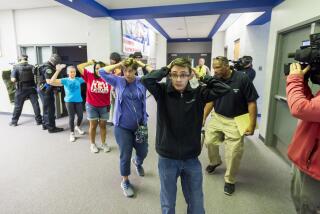Avoiding Needless Military Deaths : Training Mustn’t Be More Hazardous Than Real Combat
- Share via
The tragic death this year of 19-year-old Lee William Mirecki at the Pensacola (Fla.) Naval Air Station is only the latest example of a chronic problem plaguing the U.S. armed services. How hard, how far must military trainees be pushed in peacetime to prepare them realistically for wartime duties?
The facts revealed to date concerning Mirecki’s death provide useful insight into this problem. Briefly, the airman was undergoing voluntary training in water-rescue techniques. After demonstrating acute fear of water in training, he was found psychologically unqualified and declared his intention to leave school. Subsequently he was persuaded by his family and a Navy doctor to resume training.
Regrettably, his fears took over again during a session in the pool. He refused to reenter the water and clung tightly to a metal rack while screaming in fear, crying and saying, “I quit, I quit, DOR” (Drop on Request). Five instructors ordered 26 other students to turn away from Mirecki and to do exercises and sing while they forced Mirecki into the pool and pushed his head under water. At some point in this process he suffered a fatal heart attack.
Where should the line have been drawn between realistic training and unreasonable coercion that would have prevented this death? The beginning of an answer is found in the objectives of military training. From the first moment, the system seeks to inculcate all service members with “an obedient response.” Easy, reasonable obedience is not enough. Obedience must be a reflexive response no matter how unreasonable the order--no matter how unpleasant or dangerous the assignment. This conditioning process is deemed essential to prepare service members for prompt, unquestioning obedience in wartime.
Next, trainees are taught specific military skills where they must learn to meet arduous physical challenges and accept dangers not common outside the military. The dilemma is to make the training demanding without creating unwarranted risks. The solutions are not always successful, for a variety of reasons.
First, in peacetime there is a tendency to make training objectives exceed valid wartime requirements. An example of this problem appeared recently in Washington state, where two Navy A-6E Intruder bombers on training missions crashed a few days apart. The local commander, Rear Adm. Fredrick J. Metz, suggested that there was a possibility that training was being conducted in conditions harsher than real combat. “Why train for something if the requirement isn’t there?” he asked.
Second, the services provide a violent environment in which the line between unavoidable accidents and training excesses is blurred. Last year 1,596 servicemen and women died violent deaths, according to the Department of Defense--a rate approximately double that for U.S. civilians. Data provided concerning these deaths do not separately identify deaths in training activities, but it is probable that other “Mireckis” are among the hundreds of reported “accidental” deaths. It is noted that Mirecki’s death was originally reported to his family as an unfortunate accident, and became the subject of a criminal investigation only after other trainees began to report the actual circumstances.
Training casualties often arise from the overzealous performance of relatively junior instructors without actual combat experience in the skills that they are teaching. Lacking mature judgment, they coerce trainees to perform unreasonably arduous, dangerous tasks. Their resort to coercion is rationalized because the instructors themselves possess “the obedient impulse” and demand the same unquestioning compliance with their orders.
All this suggests that the instructors who forced Mirecki into the pool and held his head under water are not criminals who intended to do him harm. Instead, it is clear that they are victims themselves of a system that makes tragedies inevitable. The issue then becomes not who to punish but how to reduce the number of avoidable training accidents.
First, training objectives must be realistic. As Adm. Metz pointed out, there is no need to train at a level of risk that exceeds wartime requirements. Inexperienced individuals cannot be permitted to impose their own distorted concepts of combat conditions in a way that makes training more dangerous than actual combat.
Second, training activities must be directly supervised by responsible, mature seniors to prevent gung-ho junior instructors from resorting to coercion.
Finally, when a peacetime volunteer demonstrates uncontrollable fear and clearly declares his unwillingness to continue training, he is no longer a volunteer. His decision must be respected.
The unpleasant truth is that there can never be a fully satisfactory solution to the problem of balancing requirements for realistic military training versus the rights and safety of service members. Human judgment will always be involved, and that is never perfect. But setting proper standards for training and ensuring that mature, experienced supervisors enforce those standards will do much to reduce the instances of wretched judgment that cost the life of Lee Mirecki.
More to Read
Sign up for The Wild
We’ll help you find the best places to hike, bike and run, as well as the perfect silent spots for meditation and yoga.
You may occasionally receive promotional content from the Los Angeles Times.






